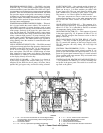
CONTENTS (cont)
Page
Water Leaks ................................64
Water Treatment ............................65
Inspect the Starting Equipment ..............65
Check Pressure Transducers ................65
Optional Pumpout System Maintenance ......65
• OPTIONAL PUMPOUT COMPRESSOR OIL
CHARGE
• OPTIONAL PUMPOUT SAFETY CONTROL
SETTINGS
Ordering Replacement Chiller Parts ..........65
TROUBLESHOOTING GUIDE ...............66-97
Overview ...................................66
Checking the Display Messages .............66
Checking Temperature Sensors ..............66
• RESISTANCE CHECK
• VOLTAGE DROP
• CHECK SENSOR ACCURACY
• DUAL TEMPERATURE SENSORS
Checking Pressure Transducers .............66
• TRANSDUCER REPLACEMENT
Control Algorithms Checkout Procedure .....67
Control Test ................................67
Page
Control Modules ............................78
• RED LED
• GREEN LEDs
Notes on Module Operation ..................78
Processor Module (PSIO) ....................79
• INPUTS
• OUTPUTS
Starter Management Module (SMM) ..........79
• INPUTS
• OUTPUTS
Options Modules (8-Input) ...................79
Replacing Defective Processor Modules ......80
• INSTALLATION
Solid-State Starters .........................81
• TESTING SILICON CONTROL RECTIFIERS
IN BENSHAW, INC. SOLID-STATE STARTERS
Physical Data ...............................85
INDEX ....................................98,99
INITIAL START-UP CHECKLIST FOR
19XL HERMETIC CENTRIFUGAL
LIQUID CHILLER ...................CL-1-CL-12
INTRODUCTION
Prior to initial start-up of the 19XL unit, those involved in
the start-up, operation, and maintenance should be thor-
oughly familiar with these instructions and other necessary
job data. This book is outlined so that you may become
familiar with the control system before performing start-up
procedures. Procedures in this manual are arranged in the
sequence required for proper chiller start-up and operation.
This unit uses a microprocessor control system. Do not
short or jumper between terminations on circuit boards
or modules; control or board failure may result.
Be aware of electrostatic discharge (static electricity) when
handling or making contact with circuit boards or mod-
ule connections. Always touch a chassis (grounded) part
to dissipate body electrostatic charge before working
inside control center.
Use extreme care when handling tools near boards and
when connecting or disconnecting terminal plugs. Cir-
cuit boards can easily be damaged. Always hold boards
by the edges and avoid touching components and
connections.
This equipment uses, and can radiate, radio frequency
energy. If not installed and used in accordance with
the instruction manual, it may cause interference to
radio communications. It has been tested and found to
comply with the limits for a Class A computing device
pursuant to Subpart J of Part 15 of FCC (Federal Com-
munication Commission) Rules, which are designed to
provide reasonable protection against such interference
when operated in a commercial environment. Operation
of this equipment in a residential area is likely to cause
interference, in which case the user, at his own expense,
will be required to take whatever measures may be re-
quired to correct the interference.
Always store and transport replacement or defective boards
in anti-static shipping bag.
ABBREVIATIONS AND EXPLANATIONS
Frequently used abbreviations in this manual include:
CCN — Carrier Comfort Network
CCW — Counterclockwise
CW — Clockwise
ECW — Entering Chilled Water
ECDW — Entering Condenser Water
EMS — Energy Management System
HGBP — Hot Gas Bypass
I/O — Input/Output
LCD — Liquid Crystal Display
LCDW — Leaving Condenser Water
LCW — Leaving Chilled Water
LED — Light-Emitting Diode
LID — Local Interface Device
OLTA — Overload Trip Amps
PIC — Product Integrated Control
PSIO — Processor Sensor Input/Output Module
RLA — Rated Load Amps
SCR — Silicon Control Rectifier
SI — International System of Units
SMM — Starter Management Module
TXV — Thermostatic Expansion Valve
The 19XL chillers use HCFC-22 and HFC-134a refrig-
erant. When referencing refrigerant charges in this manual,
the HCFC-22 charge will be listed first and the HFC-134a
value will be shown next to it in brackets [ ].
Words printed in all capital letters and italics represent val-
ues that may be viewed on the LID.
The PSIO software version number of your 19XL unit will
be located on the front cover.
4


















